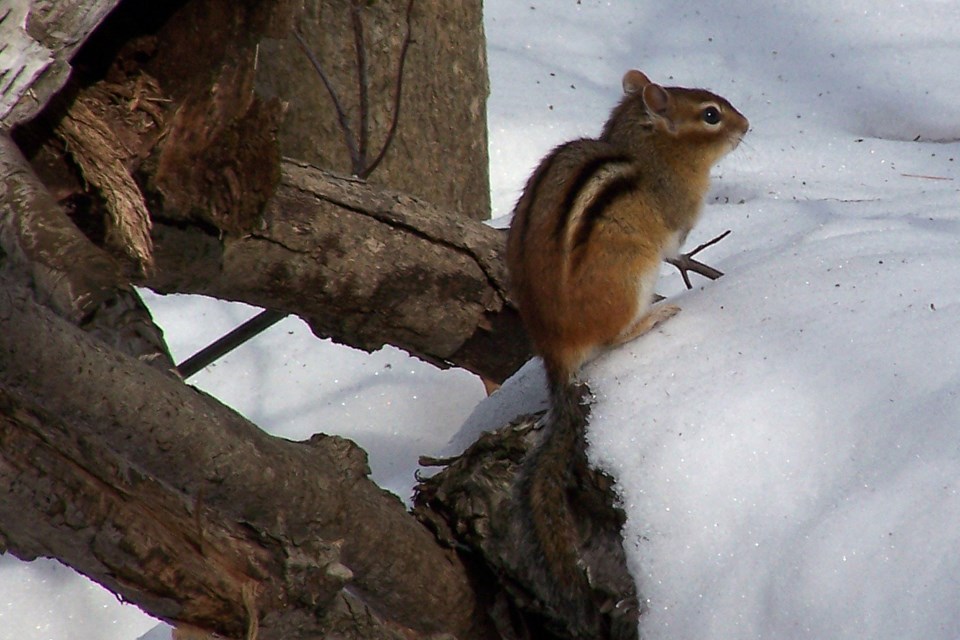In the summer months, when you are camping or at the cottage, seeing a chipmunk is a given ... they are everywhere! They are cute, frisky, and sometimes quite tolerant of humans (especially humans bearing gifts of peanuts). However, to see one in the winter months is certainly an anomaly, at least from the usual list of winter mammals.
While red squirrels and grey squirrels remain quite active in the snowy months, as do cottontail rabbits and snowshoe hare, chipmunks are usually assumed to be hibernating, snug in a deep tunnel well below the frost layer. This assumption, at least as stated here, is wrong on a couple points.
Although chipmunks are related (by being a rodent) to groundhogs and jumping mice, chippies do not truly hibernate like these two cousins. Hibernation is a very special deep sleep that requires the metabolism of the animal to decrease to a point of near death: body temperature drops to near freezing; breathing is reduced to near zero; it is the stored body fats that keep these true hibernators alive until the big thaw next spring.
Chipmunks are not like that, nor are bears, raccoons or skunks. These animals go into a state of torpor, or semi-sleep, often waking up in January and February for a bathroom break and a snack. Or to give birth, as bears and beavers do.
While larger mammals like the bear do not store extra food and must rely on that thick fat layer to keep them going, other mammals have the smarts to create a cache of edibles to sustain them through the wintertime.
Beavers gather huge piles of branches that remain accessible under the frozen ice, and chipmunks store nuts, seeds and flower bulbs in carefully constructed storage rooms along their underground passageways.
All summer long the chipmunks are ‘as busy as beavers’, digging and tunneling an underground home amongst the tree roots. Each chippie has its own territory, both male and female, and will defend it from all others for its five-year life span. The only time a female will tolerate a male within her territory is for mating, which is twice a year: early spring and late summer.
So that brings us back to seeing a chipmunk in “early spring.” Sometimes as early as mid-February, whist stumbling down the tunnel to the bathroom and seeking a stored peanut gleaned from the nice cottagers, a male chipmunk may suddenly have the urge to merge with a female.
Being a bachelor, he must now venture outside to see if any females are also up and about. Even if that means digging up through a good layer of snow. (I mean, really, how desperate is that?)
Females tend to stay snuggled inside their tunnels until all the snow has melted for good. They have enough acorns and weed seeds stored away to last them well into April, if need be.
I have observed male chipmunks on warm February days, acting not quite as ‘chippie’ as on a summer’s day, but none-the-less awake and eye-balling the landscape for lassie in need of comforting. Seeing none, it’s back to bed for another couple of weeks.
At least he can now sleep in peace while the snow lies thick and cold above. There was no rest to be had last fall when the gathering and storing of food was the all-encompassing activity of chipmunks everywhere.
As mentioned, each of these small mammals has its own territory, and there is often overlap of where Charlie’s boundary ends and Charlotte’s boundary begins. Therefore, there is a lot of time spent running from the front quarter to the back quarter to ensure the neighbours are not sneaking in and pilfering seeds from the home tunnel.
If there occurs a series of thefts, a chipmunk may turn to ‘scatter hoarding’, tucking harvested lily bulbs or acorns in random caches outside the main tunnel. It is assumed that this technique will limit overall losses while ensuring an opportunity to recover and relocate the foods from these hidden caches just before freeze up.
If the thievery stops (hooray for predators?), then these small surface caches are ignored and abandoned, which results in new plant growth next spring. Interesting how nature works, isn’t it?
This winter has proven to be a real challenge for those humans who like outdoor activities: snow, melt, freeze, snow dump, thaw, repeat. The lack of snow depth means a lack of insulation to the ground below, which means the chipmunks are waking up more often in search of body warming snacks.
And is therefore not a surprise that I see a bleary-eyed male catching some fresh air on a woodlot stump. “Sorry dude, no girls here today.” I go back to my chainsaw work and Charlie goes back to bed, each of us looking forward to the next warming thaw.
